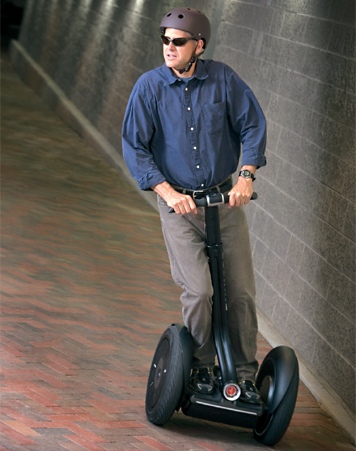|
Is a Segway in my near future? Sure they are the quint-essential douche-bag mobile. I once saw a shirtless man riding a Segway to board a cruise ship. Apparently it was prescribed by his doctor, I guess the same as a wheel chair. But did his Dr. prescribe it for cruise ship use? Or is he obvious to the man overboard risk? The movie Mall Cop perfectly depicts the Segway's appeal to fat and lazy people, especially cops, security guards, and basically anyone fine with standing on their feet but opposed to walking. Confusing I know. Why not sit or try in-line skates? Scooters? Skateboards? Bikes?
The earliest Segway prototype found its way to the market via the media, which is actually backwards compared to usual. It, of course, debuted on Good Morning America in 2001, where having a lack of actual so called "news" spurred the need for filler material. Developers saw a news anchor rolling around in Bryant Park NYC and then decided to pursue and purchased the design. The first comercialized Segway hit the market in 2002, where it was later sold to Jimi Heselden. The good thing to come out of the Segway is the engineering and prototying for better wheel chairs and medical devices to help those less mobile, such as the iBot which will be marketed to climb stairs. But back to Heselden, he was a coal miner, self made millionaire. A stand up dude, having developed Hesco a company that manufactured civilian and military devices such as the gabion used for flood control and base fortification. Heselden supported the troops by contributing to various non-profits and donations, he fully believed in giving back. Unfortunately his time was cut short, when ironically on September 26, 2010 Heselden was out "walking" his dog when his Segway fell 80 feet off the side of cliff where he died immediatly with impact. This goes to show you that innovation is great and formitable, but there is a time and a place, and sometimes the little things like the "walking" the dog shouldn't be so complex.
1 Comment
|
LAJ
100 Objects of Popular and Material Culture is an blog exploring the manifestations of human consumption and commodity-ization. The purpose of this experiment is to explore material and popular culture in contemporary society by using objects and concepts to prompt wider questions and reflections. So by emulating The British Museum's and Neil MacGregor's format of A History of the World in 100 Objects I plan to satirically analyze and reinterpreted 100 material culture objects over the course of 2014. Material Culture is the study of our culture's consumption of stuff; namely the manifestation of culture through material productions where people's perceptions of objects is socially and culturally dependent. With this, objects reflect conscious and unconscious beliefs on the the individuals who fabricated, purchased, or used them, and by extension the society where they live. So examining materiality, cultural truths and societal assumptions may be discovered. As anthropologist Arjun Appaduai states "in any society the individual is often caught between the cultural structure of commodity-ization and his own personal attempts to bring a value and order to the universe of things." Objects and commodities make up a much larger symbolic system consisting of want and need, socio-economic status, fashion, etc. Often times form follows function whether the commodity, market, and or consumer forever evolve around one-another. Philosopher Pierre Bourdieu's theories of capital flow full circle; where regardless if you are a minimalist or a hoarder the world is made up of things and everyone will leave their footprint on the earth. So by humorously analyzing marketed objects and concepts, hopefully this blog will provide further incite into ideas of over-consumption, a disposable society, consumerism vs. anti-consumers, planned obsolescence vs. sustainability, as well as the greater good of mankind and future generations. Archives
March 2015
Categories |






 RSS Feed
RSS Feed